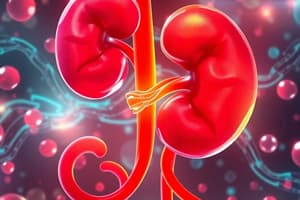Podcast
Questions and Answers
Why is furosemide (Lasix) administered to patients with fluid volume excess?
Why is furosemide (Lasix) administered to patients with fluid volume excess?
- It inhibits sodium, potassium, and chloride reabsorption in the ascending loop of Henle, leading to diuresis. (correct)
- It promotes potassium retention, reducing the risk of hyperkalemia.
- It directly increases fluid absorption in the kidneys, reducing edema.
- It stimulates aldosterone production, which helps regulate fluid balance.
A patient taking furosemide (Lasix) is also on digoxin. What electrolyte imbalance should the nurse monitor for most closely?
A patient taking furosemide (Lasix) is also on digoxin. What electrolyte imbalance should the nurse monitor for most closely?
- Hypernatremia
- Hypocalcemia
- Hyperkalemia
- Hypokalemia (correct)
Hydrochlorothiazide is prescribed for a patient with hypertension. Which dietary instruction should the nurse include in the patient's education?
Hydrochlorothiazide is prescribed for a patient with hypertension. Which dietary instruction should the nurse include in the patient's education?
- Maintain a potassium-rich diet to counter potassium loss. (correct)
- Increase sodium intake to compensate for sodium loss.
- Restrict potassium-rich foods to prevent hyperkalemia.
- Avoid calcium-rich foods to prevent hypercalcemia.
Which of the following adverse effects is associated with hydrochlorothiazide that would warrant monitoring uric acid levels?
Which of the following adverse effects is associated with hydrochlorothiazide that would warrant monitoring uric acid levels?
Spironolactone (Aldactone) is prescribed for a patient with heart failure. Which of the following indicates a potential adverse effect of this medication?
Spironolactone (Aldactone) is prescribed for a patient with heart failure. Which of the following indicates a potential adverse effect of this medication?
A patient taking spironolactone (Aldactone) should be educated to avoid excessive intake of which of the following?
A patient taking spironolactone (Aldactone) should be educated to avoid excessive intake of which of the following?
What is a primary indication for the use of testosterone therapy in males?
What is a primary indication for the use of testosterone therapy in males?
Which of the following adverse effects should a nurse monitor for in a male patient receiving testosterone therapy?
Which of the following adverse effects should a nurse monitor for in a male patient receiving testosterone therapy?
Sildenafil (Viagra) is prescribed for a patient with erectile dysfunction. What other condition is this medication also indicated for?
Sildenafil (Viagra) is prescribed for a patient with erectile dysfunction. What other condition is this medication also indicated for?
A patient taking sildenafil (Viagra) reports experiencing a prolonged erection. What instruction should the nurse provide?
A patient taking sildenafil (Viagra) reports experiencing a prolonged erection. What instruction should the nurse provide?
A patient with nasal congestion due to a cold is prescribed pseudoephedrine. Which of the following conditions should the nurse assess for before administering this medication?
A patient with nasal congestion due to a cold is prescribed pseudoephedrine. Which of the following conditions should the nurse assess for before administering this medication?
A patient who has been using pseudoephedrine nasal spray for 10 days complains of worsening congestion. What is the most likely cause?
A patient who has been using pseudoephedrine nasal spray for 10 days complains of worsening congestion. What is the most likely cause?
Diphenhydramine is prescribed for a patient with allergic rhinitis. What common side effect should the nurse educate the patient about?
Diphenhydramine is prescribed for a patient with allergic rhinitis. What common side effect should the nurse educate the patient about?
What is the primary mechanism of action of diphenhydramine in treating allergic reactions?
What is the primary mechanism of action of diphenhydramine in treating allergic reactions?
Albuterol is prescribed for a patient with asthma. What is the primary therapeutic effect of this medication?
Albuterol is prescribed for a patient with asthma. What is the primary therapeutic effect of this medication?
A patient using an albuterol inhaler reports experiencing tachycardia and palpitations. What is the nurse's priority intervention?
A patient using an albuterol inhaler reports experiencing tachycardia and palpitations. What is the nurse's priority intervention?
Isoniazid (INH) is prescribed for a patient with tuberculosis (TB). What important supplementation education should the nurse provide to the patient?
Isoniazid (INH) is prescribed for a patient with tuberculosis (TB). What important supplementation education should the nurse provide to the patient?
What is a common adverse effect of isoniazid (INH) that requires monitoring of liver function?
What is a common adverse effect of isoniazid (INH) that requires monitoring of liver function?
Rifampin is prescribed for a patient with tuberculosis. What common side effect should the nurse inform the patient about?
Rifampin is prescribed for a patient with tuberculosis. What common side effect should the nurse inform the patient about?
What does the formula Body Weight Dosage = mg/kg x Patient Weight (kg) calculate?
What does the formula Body Weight Dosage = mg/kg x Patient Weight (kg) calculate?
Flashcards
Furosemide (Lasix) use
Furosemide (Lasix) use
Used for edema with CHF, liver or kidney disease, and hypertension.
Furosemide mechanism
Furosemide mechanism
It inhibits sodium, potassium, and chloride reabsorption in the ascending loop of Henle, causing diuresis
Furosemide: Adverse Reactions
Furosemide: Adverse Reactions
Hypokalemia, dehydration, electrolyte imbalance, hypotension, ototoxicity, hyperglycemia.
Hydrochlorothiazide Use
Hydrochlorothiazide Use
Signup and view all the flashcards
Hydrochlorothiazide Mechanism
Hydrochlorothiazide Mechanism
Signup and view all the flashcards
Hydrochlorothiazide: Adverse Reactions
Hydrochlorothiazide: Adverse Reactions
Signup and view all the flashcards
Spironolactone Use
Spironolactone Use
Signup and view all the flashcards
Spironolactone Mechanism
Spironolactone Mechanism
Signup and view all the flashcards
Spironolactone Adverse Reactions
Spironolactone Adverse Reactions
Signup and view all the flashcards
Testosterone Use
Testosterone Use
Signup and view all the flashcards
Testosterone Mechanism
Testosterone Mechanism
Signup and view all the flashcards
Testosterone: Adverse Reactions
Testosterone: Adverse Reactions
Signup and view all the flashcards
Sildenafil (Viagra) Use
Sildenafil (Viagra) Use
Signup and view all the flashcards
Sildenafil Mechanism
Sildenafil Mechanism
Signup and view all the flashcards
Sildenafil: Adverse Reactions
Sildenafil: Adverse Reactions
Signup and view all the flashcards
Pseudoephedrine Use
Pseudoephedrine Use
Signup and view all the flashcards
Pseudoephedrine Mechanism
Pseudoephedrine Mechanism
Signup and view all the flashcards
Pseudoephedrine: Adverse Reactions
Pseudoephedrine: Adverse Reactions
Signup and view all the flashcards
Diphenhydramine Use
Diphenhydramine Use
Signup and view all the flashcards
Diphenhydramine Mechanism
Diphenhydramine Mechanism
Signup and view all the flashcards
Study Notes
Loop Diuretics – Furosemide (Lasix)
- Use: Treats edema from congestive heart failure, liver disease, kidney disease, and hypertension
- Action: Blocks sodium, potassium, and chloride reabsorption in the ascending loop of Henle, increasing diuresis
- Side effects: Hypokalemia, dehydration, electrolyte imbalance, orthostatic hypotension, ototoxicity (especially with rapid IV), and hyperglycemia
- Nursing: Monitor electrolytes, renal function (BUN, creatinine), and fluid balance; assess for dehydration, orthostatic hypotension, and electrolyte imbalances; advise taking in the morning
Thiazide Diuretics – Hydrochlorothiazide (Hydrodiuril)
- Use: First-line for hypertension and edema from mild heart failure or renal disease
- Action: Stops sodium and chloride reabsorption in the distal tubule, increasing urine
- Side effects: Hypokalemia, hyperglycemia, hyperuricemia (can worsen gout), dehydration, dizziness, and weakness
- Nursing: Monitor blood pressure, electrolytes (especially potassium and sodium), and blood glucose; encourage a potassium-rich diet
Potassium-Sparing Diuretics – Spironolactone (Aldactone)
- Use: Treats hypertension, heart failure, conditions causing hypokalemia, and hyperaldosteronism
- Action: Aldosterone antagonist; inhibits sodium retention and potassium excretion in the distal tubule, causing mild diuresis and preserving potassium
- Side effects: Hyperkalemia, gynecomastia (in males), menstrual irregularities, and dizziness
- Nursing: Monitor potassium, renal function, and blood pressure; tell patients to avoid potassium-rich foods and supplements
- Foods high in potassium: Bananas, oranges, tomatoes, spinach, potatoes, and avocados
Androgens – Testosterone
- Use: For hypogonadism, delayed puberty, and hormone replacement in males; also for some female breast cancers
- Action: Binds to androgen receptors, boosts male characteristics and muscle growth
- Side effects: Acne, liver dysfunction, fluid retention, mood changes, high cholesterol, and cardiovascular risks
- Nursing: Monitor liver function, lipid levels, hemoglobin, and hematocrit; educate about misuse risks
- Anabolic steroids: High misuse potential among athletes for muscle growth, which can result in cardiovascular issues, liver damage, and psychological problems
PDE5 Inhibitors – Sildenafil (Viagra)
- Use: Treats erectile dysfunction and pulmonary arterial hypertension
- Action: Inhibits phosphodiesterase type 5 (PDE5), increasing cyclic GMP, relaxing smooth muscle, and improving penis blood flow
- Side effects: Headache, flushing, hypotension, priapism (prolonged erection), and vision disturbances
- Nursing: Contraindicated with nitrates (can cause severe hypotension); educate on usage and interactions
Nasal Decongestants – Pseudoephedrine
- Use: Provides temporary relief from nasal congestion due to colds, allergies, and sinus infections
- Action: Alpha-adrenergic agonist causing vasoconstriction in nasal mucosa, which reduces swelling and congestion
- Side effects: Hypertension, insomnia, dizziness, tachycardia, and restlessness
- Nursing: Use cautiously in patients with hypertension or cardiovascular disease; avoid prolonged use (>3 days) to prevent rebound congestion
First Generation H1 Receptor Antagonists – Diphenhydramine
- Use: Treats allergic reactions, motion sickness, and insomnia
- Action: Blocks H1 receptors, reducing histamine-induced allergic symptoms
- Side effects: Drowsiness, dry mouth, dizziness, and urinary retention
- Nursing: Warn about sedation and avoid alcohol; use caution in elderly patients
Adrenergics – Albuterol
- Use: For acute bronchospasm, asthma, and COPD
- Action: Beta-2 adrenergic agonist that relaxes bronchial smooth muscles, causing bronchodilation
- Side effects: Tachycardia, palpitations, tremors, nervousness, and paradoxical bronchospasm
- Nursing: Monitor heart rate, teach proper inhaler technique, and warn against overuse
Isoniazid (INH)
- Use: First-line treatment for active and latent TB
- Action: Inhibits mycolic acid synthesis in TB bacteria, which leads to bacterial cell death
- Side effects: Hepatotoxicity, peripheral neuropathy, and gastrointestinal upset
- Nursing: Monitor liver function; recommend Vitamin B6 supplementation
Rifampin
- Use: Treats TB and provides prophylaxis for meningococcal disease
- Action: Inhibits bacterial RNA synthesis
- Side effects: Hepatotoxicity, red-orange discoloration of body fluids, and GI upset
- Nursing: Monitor liver function, warn about body fluid discoloration, and advise against alcohol
Henke's Med-Math
- Key topics: Dosage calculations, IV flow rates, weight-based dosing, and conversions
- Formulas:
- IV Flow Rate (mL/hr) = Total Volume (mL) / Time (hr)
- Dosage Calculation = (Desired Dose / Available Dose) × Volume
- Body Weight Dosage = mg/kg × Patient Weight (kg)
Studying That Suits You
Use AI to generate personalized quizzes and flashcards to suit your learning preferences.




